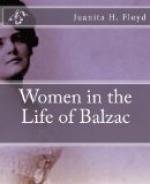“Daughter of an enslaved land, an angel in love, a demon in imagination, a child in faith, an old man in experience, a man in brain, a woman in heart, a giant in hope, a mother in suffering and a poet in your dreams,—this work, in which your love and your fancy, your faith, your experience, your suffering, your hopes and your dreams are like chains by which hangs a web less lovely than the poetry cherished in your soul—the poetry whose expression when it lights up your countenance is, to those who admire you, what the characters of a lost language are to the learned—this work is yours.
“DE BALZAC.”
In La fausse Maitresse, Balzac represented Madame Hanska in the role of the Countess Clementine Laginska, who was silently loved by Thaddee Paz, a Polish refugee. This Thaddee Paz was no other than Thaddee Wylezynski, a cousin who adored her, and who died in 1844. Balzac learned of the warm attachment existing between Madame Hanska and her cousin soon after meeting her, and compared his faithful friend Borget to her Thaddee. On hearing of the death of Thaddee, he writes her: “The death of Thaddee, which you announce to me, grieves me. You have told me so much of him, that I loved one who loved you so well, although! You have doubtless guessed why I called Paz, Thaddee. Poor dear one, I shall love you for all those whose love you lose!”
Balzac longed to be free from his debts, and have undisturbed possession of Les Jardies, where they could live en pigeons heureux. Ever inclined to give advice, he suggested to her that she should have her interests entirely separate form Anna’s, quoting the axiom, N’ayez aucune collision d’interet avec vos enfants, and that she was wrong in refusing a bequest from her deceased husband. She should give up all luxuries, dismiss all necessary employees and not spend so much of her income but invest it. He felt that she and her daughter were lacking in business ability; this proved to be too true, but Balzac was indeed a very poor person to advise her on this subject; however, her lack of accuracy in failing to date her letters was, to be sure, a great annoyance to him.
On the other hand, she suspected her Nore, had again heard that he was married, and that he was given to indulging in intoxicating liquors; she advised him not to associate so much with women.
Having eventually won her lawsuit, she returned to Wierzchownia in the spring of 1844, after a residence of almost two years in St. Petersburg. Her daughter Anna had made her debut in St. Petersburg society, and had met the young Comte George de Mniszech, who was destined to become her husband. Balzac was not pleased with this choice, and felt that the protege of the aged Comte Potocki would make a better husband, for moral qualities were to be considered rather than fortune.




